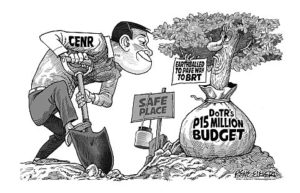
Cebu City Hall may want to explain to Teresita Ruiz, a resident of Barangay Kamputhaw, Cebu City, why the trees that line up along the proposed Bus Rapid Transit (BRT) route will have to go.
She said the trees provide shade to her home during the summer season, and with the unrelenting heat and her advanced age, the trees are small comfort for her and her family.
There is no easy explanation for the removal other than it is necessary to pave the way for the full construction of the BRT, a long-gestating project that is seen to provide Cebu City’s commuters a viable mass transport system that will eventually become the preferred public transportation mode if City Hall manages to implement it successfully.
And based on the explanations given by City Hall, it looks as if the earthballing process is the most viable solution to allow the project to continue unless the environmentalists manage to convince the city residents and the powers that be to somehow radically alter the designs in order to build around and not cut the trees if it is at all possible.
Based on some readings of the stakeholders that attended the recent dialogue on the cutting of the trees along the BRT route, a lot of them are rather more concerned about their properties being displaced than the trees themselves.
Perhaps they have acknowledged for better or worse that the trees have to go to give way to the BRT project.
The Movement for Livable Cebu, for instance, was open to cutting down the aging trees so long as they’re not native to Cebu — not that their opinionwould matter to the powers that be who are determined to push through with the BRT project even if it means cutting down all trees in its routes.
In fact, the earthballing of the trees is a small victory if it can be called that for those wishing to preserve as much of them as possible, and this runs counter to the local administration’s position to cut down all trees and replace them with seedlings since it is a lot cheaper that way.
As it is, there is a P15-million budget to pay for the earthballing that will be taken out of the P35-million “green” component of the project that will be paid for by the Department of Transportation (DOTr) and will be implemented by the City Environment and Natural Resources Office (Cenro).
As reiterated earlier, the project is bankrolled and will be implemented by the national government and will be paid for by the country’s taxpayers; so no one local official, unless he or she has deep connections with the Palace, can decide how the funds will be spent for the project.
That a budget had been allocated for this purpose, plus assurances by City Hall that the survival rate for earthballed trees is high provided it is carried out properly, assures city residents that these trees will continue to live and provide shade to others for years to come.